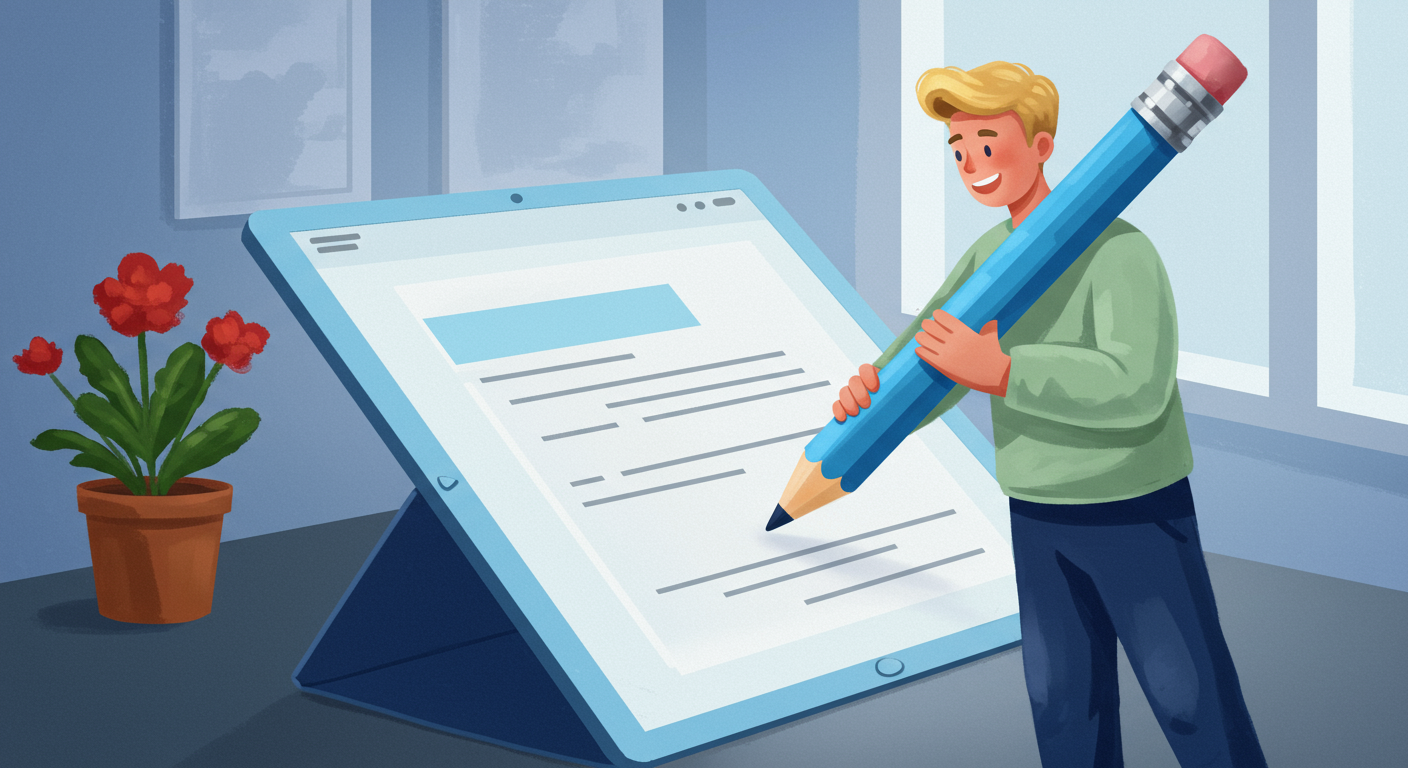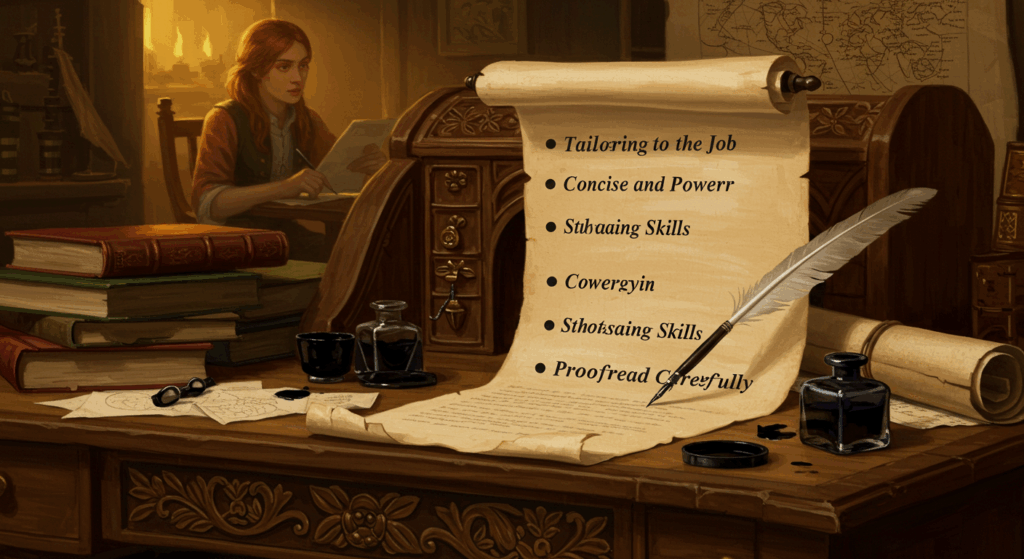You don’t have to be a poet or a LinkedIn celeb to write a good cover letter. You just need to sound like a real person who knows what they bring to the table. Think of it like a DM to a future boss: short, thoughtful, and not weird. In this guide, I’m going to show you how to write a cover letter that feels modern and human—complete with the right greeting, a tight body, and a confident closing—without falling into that stiff “To whom it may concern, I am writing to express…” trap. We’ll go step by step, with examples and mini templates, and I’ll spill the tiny things that make recruiters go “okayyy, let’s interview them.”
Also, permission to be imperfect? Granted. I’ll keep the tone casual (a little messy, a little “ngl”), because that’s how a lot of us actually write. You can tidy it up before sending.
What a Cover Letter Actually Does (and why it still matters)
A cover letter is your highlight reel plus context. Your résumé says what you did; the cover letter says why it matters here. It’s where you connect the dots between your experience and their needs, show a bit of personality, and make a small ask (aka the closing). But It’s not a memoir. It’s not a copy-paste. It’s you sasying: “Here’s the problem you’re hiring to solve. Here’s how I’ve solved similar stuff. Here’s how we win together.”
Quick truths:
- One page max (3–5 short paragraphs). Brevity is respect.
- Personalization beats buzzwords like “dynamic self-starter” (yawn).
- Metrics catch eyes. “Grew TikTok from 0 → 24k in 6 months” > “Managed social media.”
- ATS doesn’t parse cover letters like résumés do, but keywords still help. Sprinkle role-specific terms where they naturally fit in the body.
The 5-Part Structure (so your brain can chill)
Most great cover letters follow a simple arc:
- Header (contact info + date + company info)
- Greeting (human, accurate, not “Sir/Madam” unless you time-traveled)
- Hook/opening (one tight paragraph with your angle)
- Body (1–2 paragraphs connecting your wins to their needs)
- Closing (clear next step + sign-off)
If you nail the greeting, body, and closing, you’re 90% there.
The Header: Keep It Clean
Top of the page:
- Your name, phone, email, portfolio/LinkedIn
- Date
- Hiring manager’s name, title, company, and city (or “Remote”)
Looks like this:
Taylor Nguyen
taylor.nguyen@email.com | 555-123-7890 | linkedin.com/in/taylornguyen | taylormakesstuff.com
September 23, 2025
Anna Jane Catherine
Head of Product Marketing
Glow Apps
Remote
No need for your full home address unless required. Keep it modern.
The Greeting: Say “Hi” Like a Human
The greeting sets the vibe. If you can find a name, use it:
- “Hi Anna,” (yes, “Hi” is fine in 2025)
- “Hello Ms. Rahman,” (if you’re unsure about casual vibe)
- “Dear Hiring Team,” (when you can’t find a specific name)
- Avoid “To whom it may concern”—it concerns them, not whom.
If you’re not sure who to address, check the job post, the company’s careers page, or the team’s LinkedIn. BUT If still nothing, “Hi Product Marketing Team,” is totally okay.
Quick tips for the greeting
- Spell their name right (double-check—seriously).
- If there are two names, choose the most senior or the one listed on the posting.
- Inclusive default: first name + comma. Clean, friendly.
The Opening Hook: 3–4 Sentences, Max
This isn’t a paragraph about “my passion since childhood.” Keep it punchy:
- Name the role.
- Drop a relevant win/angle.
- Show you get what they’re solving.
- Connect to their product/mission/market.
Example:
Hi Anna,
I’m excited to apply for the Product Marketing Manager role at Glow. In my last role at Lumi, I launched three feature campaigns that lifted trial-to-paid by 18% and reduced churn 7% quarter-over-quarter. I love how Glow positions mental wellness as daily, not “emergency use,” and I’m ready to help you ship product stories people actually feel.
Notice it’s specific (numbers), short, and shows I did my homework. No fluff, no paragraph-long flexing.
The Body: Tell Short Stories That Map to Their Needs
The body is where you connect your experience to the job post. If they want “go-to-market strategy, lifecycle messaging, and cross-functional collaboration,” your body should mirror those buckets with 2–3 prof points. Use mini STAR (Situation, Task, Action, Result) beats. Two tight paragraphs or a short bullet list—both are fine.
Body paragraph blueprint:
- What was broken / goal?
- What did you actually do? (tools, cross-teams, strategy)
- What happened (metric, timeline, scale)?
Example body paragraph:
At Lumi, our onboarding emails were “meh,” bouncing users after signup. I rebuilt lifecycle journeys around job-to-be-done moments, partnering with Product to trigger messages from in-app events. We A/B tested copy and added 2 nudges in week 1; activation moved from 34% → 51% in 90 days, and support tickets on onboarding dropped 22%.
Or bullet version for clarity:
- Rebuilt GTM brief template; cut launch timeline by 2 weeks while maintaining QA gate
- Ran 14 customer interviews to reposition “Focus Timer” feature; +28% feature adoption
- Partnered with Sales to create a 6-slide narrative; helped close two $120k logos
What to include in the body (and what to skip)
Include:
- Metrics (even rough), tools (HubSpot, Figma, Python, SQL), and scale (“supported 14 markets”)
- Collaborations (“paired with Data/UX/Legal”)
- Role-specific keywords (naturally placed)
Skip:
- Rehashing your entire résumé
- Vague hype (“excellent communication skills” with zero receipts)
- Long timelines of your career path (save that for the interview banter)
The Closing: Make a Specific Ask (and don’t overthink it)
The closing is your call to action. Keep it confident but chill:
- “I’d love to chat about how we can grow Glow’s trial-to-paid funnel this quarter. Are you free next week?”
- “If helpful, I can share the lifecycle audit I built for a similar product. Thanks for considering my application.”
- “I’m excited about the role and ready to start interviews whenever you are.”
Then sign off:
- “Best,” “Warmly,” “Thanks so much,”
- Your name
Optionally add a P.S. for one extra nugget:
P.S. I noticed your new “Daily Check-In.” I have 3 quick experiments to test in week one (one is a meme-based nudge, hear me out 😅).
Closing mistakes to avoid
- Don’t apologize (“Sorry for the long letter”—also, it shouldn’t be long).
- Don’t demand (“I expect to hear from you by Friday.” Sir, what.)
- Don’t be vague (“Hope to connect sometime”)—give them an easy next step.
How Long Should It Be?
Aim for 250–400 words. That’s it. This is not your Spotify Wrapped. If you’re pushing 550+ words, cut a paragraph or move a story to your résumé or portfolio.
Tone Check: Professional, but not robotic
You’re not writing a legal brief. You’re also not tweeting. The center lane:
- Short sentences, active voice
- Specific verbs (launched, rebuilt, shipped, analyzed)
- A little warmth is fine (one line of personality, not a stand-up set)
Formatting Basics (that lowkey matter)
- Font: system sans (Arial/Calibri/Helvetica) or a clean serif (Georgia). 11–12 pt.
- Margins: 1 inch-ish.
- Single space; blank line between paragraphs.
- PDF, unless the application specifically asks for a doc or plain text field.
- Match the résumé header for a cohesive look.
Research in 9 Minutes (the cheat sheet)
You don’t need a PhD on the company, just enough to not sound generic:
- Read the job description—highlight top 3 responsibilities and 3 must-have skills.
- Skim the website and a recent blog or press update.
- Peek at LinkedIn for team size or the hiring manager’s background.
- Note the language they use: customers = “members” or “clients”? Product = “platform” or “app”? Mirror lightly in your body.
Keywords Without the Cringe
Use the job post’s terms naturally:
- If they say “lifecycle marketing,” say “lifecycle,” not “email drip” (unless both are used).
- If they say “SQL preferred,” a line like “comfortable with SQL for quick retention pulls” works.
- Keep it honest. Don’t flex a tool you’ve never touched (they will ask).
How to Personalize Fast (even for 10 applications… it happens)
- Greeting: Use a name or team.
- Opening: Mention one relevant product, initiative, or goal from the posting.
- Body: Map 2 wins directly to their top two needs.
- Closing: Make a specific, job-related ask.
Personalization ≠ rewriting the whole thing; it’s targeted tweaks. Save a base draft, then adjust.
The “Greeting, Body, Closing” Mini-Templates (steal these)
Template 1: Early-Career / New Grad
Greeting
Hi [Hiring Manager Name],
Opening
I’m applying for the [Role] at [Company]. As a [Degree/Major or Bootcamp] grad who led two team projects (including a [relevant project]), I’m excited to contribute to [Company mission/product].
Body
In my capstone, I [action + tools], which led to [result/metric]. During my internship at [Org], I [action], improving [metric/outcome]. I’m comfortable with [skills/tools from job post] and love learning on the fly (ngl, tinkering is my hobby).
Closing
I’d love to share how I can support [team goal]. Are you open to a quick chat next week?
Best,
[Name]
Template 2: Career Switcher
Greeting
Hello [Hiring Team],
Opening
I’m excited to apply for [Role]. I’m moving from [Old Field] to [New Field], and the common thread in my work is [transferable skill], which maps directly to [job responsibility].
Body
At [Old Company], I [action], which resulted in [metric]. I completed [relevant cert/course/portfolio]. I’m already using [tool] to [relevant action], and here’s a quick win I’d tackle in month one: [specific idea].
Closing
Thanks for considering my application. I’d love to discuss how I can bring a fresh perspective to [team].
Warmly,
[Name]
Template 3: Experienced Contributor
Greeting
Hi [Name],
Opening
I’m a [X]-year [Role] who’s shipped [two relevant outcomes]. I’m applying to [Company] because [specific product/goal] is exactly the kind of challenge I like.
Body
At [Company], I [action + collaboration], which drove [metric across timeline]. I also [second result]. I work closely with [cross-teams] and I’m fluent in [tools/stack]. I’ve attached [portfolio/demo] showcasing projects similar to [Company]’s roadmap.
Closing
I’d love to talk through how we can replicate these wins for [Company].
Thanks,
[Name]
Template 4: Internship
Greeting
Dear [Team Name],
Opening
I’m a [year/major] at [School] applying for the [Internship]. I’ve built [project], and I’m especially into [specific part of the company’s work].
Body
In class and clubs, I [action], which led to [result]. I’m comfortable with [tools], and I’m quick to prototype ideas. I’d love to contribute to [team initiative].
Closing
Thank you for your time—would you be open to a brief interview?
Best,
[Name]
Short Example Letters (copy, tweak, send)
Example: Product Marketing Manager
Hi Anna,
I’m excited to apply for the Product Marketing Manager role at Glow. At Lumi, I launched three feature campaigns that lifted trial-to-paid by 18% and cut churn by 7% QoQ. Glow’s focus on daily mental wellness, not “just in crisis,” really resonates with me.
In the last year, I rebuilt our GTM brief to align Product, Sales, and Support on one simple source of truth. We trimmed launch time by two weeks and increased activation by 17% through event-based lifecycle emails. I also ran 14 customer interviews to reposition our “Focus Timer,” which drove a 28% bump in feature adoption.
I’d love to chat about how we can grow Glow’s trial-to-paid funnel this quarter. If helpful, I can share a lifecycle audit I built for a similar product.
Best,
Taylor
Example: Data Analyst (Career Switch from Ops)
Hello Hiring Team,
I’m applying for the Data Analyst role. After three years in Operations, I completed a Google Data Analytics cert and have been using SQL and Python to automate weekly reporting. I’m excited about [Company]’s commitment to self-serve analytics.
At BrightCo, I consolidated five spreadsheets into a single BigQuery table and built a Looker dashboard that cut weekly prep time by ~6 hours and revealed a repeat-returner trend that improved forecasting accuracy by 12%. I love translating messy data into the one graph that makes everyone go “ohhh, that’s the thing.”
Could we set up a short call to discuss how I can support your analytics roadmap?
Thanks so much,
Maya
Common Mistakes (and how to unfail them)
- Generic greeting: Personalize the greeting or at least name the team.
- Fluffy body: Replace adjectives with actions and metrics. “Collaborative” → “Partnered with Sales & Legal to ship pricing overhaul; +9% ARPU.”
- Weak closing: Ask for a conversation and reference a specific business goal.
- Overlength: If it scrolls on mobile, it’s probably too long. Trim.
- Typos: One or two casualisms are cute; misspelling the company name is not cute. (Spellcheck is free.)
What If There’s a Text Box (no upload allowed)?
- Paste your letter plain-text.
- Keep the greeting and closing.
- Remove the header (the form already knows you).
- Line breaks matter—double-space between paragraphs for readability.
Emailing the Letter vs Attaching It
- If the job portal wants a PDF, attach it.
- If you’re cold-emailing, the email is the cover letter. Put the greeting at the top and your résumé attached below. Subject line: “Taylor Nguyen — Product Marketing Manager Application.”
- Still include a call-to-action closing.
“But I Have No Experience”
You have relevant experience; maybe it just didn’t happen at a place with free snacks. Pull from:
- Class or bootcamp projects
- Freelance or volunteer work
- Clubs/organizing/competitions
- Personal builds (portfolio pieces count if they show the right skills)
Show outcomes (“designed a 3-screen onboarding in Figma,” “ran a usabiity test with 7 users,” “improved Lighthouse performance score from 62 → 91”).
“Do I Mention Salary or Visa or Remote?”
Not in the cover letter unless the posting explicitly asks for salary expectations. Visa/remote preferences typically live with HR forms and later chats. The cover letter’s job is to get you the interview, not negotiate.
A Quick “Greeting, Body, Closing” Checklist
- Greeting
- Uses a name or specific team
- Spelled correctly (pls triple-check)
- Body
- 2–3 proof points, each with an action + metric
- Mirrors top needs from the job post
- Includes a few relevant keywords/tools naturally
- Closing
- Specific ask for a conversation
- Friendly sign-off with your name
- Optional P.S. with a fun/professional extra
Micro-Edits That Level You Up in 3 Minutes
- Replace “responsible for” with a verb (launched, built, analyzed, shipped).
- Add one metric per paragraph (percent change, time saved, revenue impact).
- Cut long wind-ups (“I am writing to express…”) to a single, strong first line.
- Mirror their language: if they say “members,” don’t say “customers.”
- Use white space. Short paragraphs = easier skim.
Advanced Moves (for the nerds, ily)
- Portfolio cueing: In the body, reference a specific project name they can click (“See Project 3: Retention Audit”).
- Day-30 idea: Drop one quick, realistic experiment you’d try your first month.
- Social proof: If you have a quote from a client or manager (“best launch doc we’ve used”), one sentence can land nicely in the closing or P.S.
How to Write Faster (because the job search is a job)
- Create one “master” base letter with your strongest 4–5 wins.
- For each application, tweak the greeting, the first paragraph, and one body paragraph to match their top need.
- Keep a swipe file of good lines and metrics in Notion/Google Docs.
- Set a 25-minute timer (Pomodoro), draft messy, then tidy for 10 minutes. Done.
When to Skip a Cover Letter (hot take)
If the application explicitly says “no cover letter,” don’t force it. But if there’s an optional field, use it. Optional is recruiter-speak for “signal that you care.” And honestly, a smart greeting, tight body, and simple closing can be the difference when your résumé is tied with someone else’s.
One More Full Example (because sometimes you just want to see it)
Hi Jordan,
I’m applying for the Growth Marketing Specialist role at Sproutly. Over the past two years at Nestly, I built paid + lifecycle experiments that grew monthly signups 32% while lowering CAC by 14%. I’m excited about Sproutly’s push into community-led growth and would love to help you scale it.
Recently I rebuilt our onboarding with event-based triggers (Amplitude + Braze), focusing on two “aha” moments. We shipped a 4-email sequence mapped to user intent, tested creative weekly, and added an in-product nudge—activation lifted from 38% → 55% in 90 days. I also launched a UGC micro-program that added 1,200 qualified leads per quarter at <$3 CPL.
I’d love to chat about bootstrapping experiment velocity at Sproutly and aligning lifecycle with paid and product. Could we find 20 minutes next week?
Thanks so much,
Riley Chen
Short. Specific. Friendly. That’s the vibe.
Final Touches Before You Hit Send
- Read it out loud. If you’re gasping for air, it’s too long.
- Check names, titles, and… the company’s name (yes, people mess this up).
- Export as PDF with a clear filename:
Taylor-Nguyen-Cover-Letter-Glow.pdf. - Upload, or paste into the text box with the greeting, body, and closing intact.
Tiny FAQ (because I know you’re thinking these)
Should I add humor?
Light, situational humor is fine. One emoji max, if any. You’re applying for a job, not auditioning for Netflix.
Do I mention that I’m applying to other companies?
Nope. They assume that. Focus on them.
Can I use AI to draft it?
Sure—but personalize and fact-check. Add your real metrics and voice. The goal is “sounds like you on your best day,” not “ChatGPT-core corporate beige.”
If you’ve made it this far, you’re already ahead of most applicants (seriously). Draft your base version today, then ship one tailored greeting, one targeted body paragraph, and a confident closing for each role. You’ve got the skills—let’s get them seen. Hit send, get that interview, and go snag the offer. You’ve got this.









